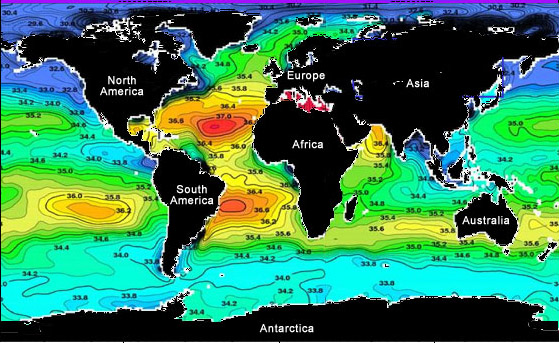3. The Conveyor and Global Warming (1/2)
The global conveyor has a strong influence on how our planet responds to increasing levels of atmospheric carbon dioxide (CO2):
- It interacts with the global carbon cycle to remove CO2 from the air and store it in the deep ocean
- It influences the way in which global warming is likely to change regional patterns of temperature and rainfall.
The deep ocean: a temporary CO2 store
The ocean contains over 50 times as much CO2 as the atmosphere, most of it in the deep ocean where it is effectively locked away from the atmosphere. At present the ocean absorbs about a third of the world's CO2 emissions, but this may change in the future.
Atmospheric CO2 is brought into the deep ocean in two ways:
- directly when water with dissolved CO2 sink in the North Atlantic
- through the 'biological pump': when dead marine organisms sink and decompose.
'Old carbon' (carbon that has been stored in the ocean for hundreds of years) returns to the surface in upwelling regions and the Southern Ocean.
Uptake of CO2 gas
The amount of gas dissolved in water is generally in proportion to its amount in the atmosphere, but also depends on temperature (T) and salinity (S). Increasing T or S reduces the amount of gas that ocean water can dissolve.
- Water from the Gulf Stream cools down on its journey towards the northwest. The salinity also changes (see map). What effect does this have on the water's ability to take up CO2 along the way?
- How would global warming affect the uptake of CO2 by water sinking in the North Atlantic?
How seawater stores CO2
Seawater can hold much more CO2 than expected simply from the low concentrations in the atmosphere (390 ppm or 0.039%).
Once CO2 enters the water, it reacts with the water to become hydrogen carbonate (HCO3-) and carbonate (CO32-) ions. This reduces the amount of dissolved CO2 gas and allows the water to take up more from the atmosphere.
Marine snow
Marine snow is the name given to the continuous shower of organic detritus that falls from the sunlit upper layers into the deep ocean. It consists of dead or dying animals and plants, fecal matter, and inorganic dust, clumped together in loose flocs. In the deep ocean it is consumed by a variety of animals or decomposes.
This mechanism for transporting carbon into the deep ocean is known as the biological carbon pump.
- What effect does marine snow have on the CO2 concentration in the deep ocean?
- How do you think the amount of CO2 in recently formed deep water compares with that in 'old water' that left the surface hundreds of years ago?
- What is likely to happen to the CO2 in this 'old water' when it returns to the surface?
Return to the surface
The old water is rich in plant nutrients, so the regions where it surfaces have high plant production. The plants use up much of the CO2 in the water before it can be released, and some of this is returned to the deep as marine snow. Never-the-less, the upwelling regions and the Southern Ocean are generally a source of atmospheric CO2.
At the moment these source regions release less CO2 to the air than the amounts brought into the deep ocean by North Atlantic deep water formation and the biological carbon pump.
- What do you think might happen when the deep water that was formed after the start of the industrial revolution returns to the surface?
- What effect might this have on the ability of the ocean to take up human CO2 emissions in the future?



